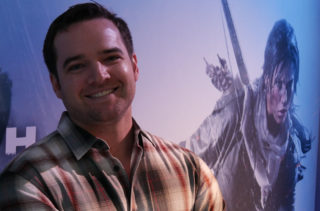The Rise of the Tomb Raider: 20 Year Celebration edition launches next week on PlayStation 4. Not only does it include new adventures, it has all the downloadable content, and it is enhanced to take advantage of the PlayStation Pro’s advanced features, including HDR (high dynamic range) graphics.
Furthermore, the 20 Year Celebration includes standalone adventures called Lara’s Nightmare and Blood Ties, the latter of which has been adapted into a virtual reality experience using PlayStation VR (PSVR).
In Blood Ties, Lara is in danger of losing possession of her ancestral home and must search through its secrets and history in order to keep it. However, exploring the forgotten parts of Croft Manor is no easy task, as much of it is in serious disrepair. It may not be a tomb, but it can feel like one at times. Still, it is a critical part of Lara’s life, and it represents her legacy, her fortune and her childhood. Although the experience doesn’t involve shooting or acrobatics, fans will get a more intimate look at the legendary tomb raider’s history.

Chris Johnson, associate brand manager at Crystal Dynamics, spoke with [a]listdaily at a New York Comic-Con event about the new features found in the Rise of the Tomb Raider: 20 Year Celebration and how the character of Lara Croft has evolved over the two decades. He said that “With the 20 Year Celebration, we wanted to bring Lara’s Manor into the modern timeline. When players first got the cinematic experience of Lara in her childhood home, fans went totally nuts. Now is the perfect time to bring this to life.”
When asked what inspired the creation of a Tomb Raider VR experience, Johnson replied: “We knew there was going to be some new tech coming out and we were really excited to see how that could fit into our world. As we were building on the content of Lara’s manor, we felt that this would be a great experience that could also be in VR.”
Rise of the Tomb Raider can also be played in its entirety using the PSVR’s theater mode, which creates a giant virtual 2D screen. When asked about how an action game like Tomb Raider translated to virtual reality, Johnson said “all of our DLC offers something a little bit different. This particular part of content is more of the exploration side of things. As you play through the game, you’ll pick up different objects that are meaningful—more backstory, deeper narrative.”
“You can’t just go back and add VR to this. That doesn’t really work. So, as we were building this space out and adding all this adventure, we got inspiration from games like Gone Home. That’s what led us to say, ‘this would work really well in VR, let’s give it a shot.’ So, our team has been busy making that feel immersive. As you’re going through the manor, we felt really excited by it, because for the very first time, players could actually experience the world through Lara’s eyes.”
The VR experience is markedly different from the main game, starting with how players teleport Lara around the environment to move, since climbing and acrobatics don’t work well in VR. There’s more reliance on observation and Lara’s wits as an archeologist to solve puzzles. Johnson describes it as the “same flavor, different experience.”
The VR content is tied into the main Rise of the Tomb Raider story. “You’ll see lots of things from the main story that are brought into this. So, they complement each other.” For example, Lara finds a wearable flashlight while exploring the manor, which happens to be the same one she uses in the Cold Darkness Awakened DLC. As an added touch, players can rotate objects by turning the DualShock 4 wireless controller in their hands for a more tactile experience, and at one point, the controller can be used to direct the flashlight.
When asked about the challenges of keeping up with the latest technological developments, such as VR or the PlayStation Pro’s enhanced features, Johnson said “whenever there’s new technology, it presents a new set of challenges. The team is just really excited about the opportunity to try something new on a brand new platform.” Johnson then elaborated on the importance of adopting new technology by saying, “I think as a studio, at Crystal, we just love to be first. We want to be the first leading the market and pushing new technology. We want to be innovators, and that pushes us to get new ideas and find and create beautiful things.”
So, how does Crystal Dynamics keep a 20-year-old character relevant? “I think that’s what we did when we did Tomb Raider 2013,” said Johnson. “We wanted to create a character that has a very strong legacy, but keep to the core tenants of the franchise: action, adventure, exploration and puzzle solving. But bringing in a modern and fresh take where we grounded it in realism. We also took this fact-based fiction and pushed that into this realistic reboot.”
Lara Croft has gone through a great many changes over the past two decades. “As a character, she’s evolved incredibly,” Johnson said “and now we want to create this more relatable character. I think that’s what we deliver now with Rise of the Tomb Raider. Lara is going on her first tomb raiding expedition and searching for this hidden truth.”
Johnson added that “it’s exciting. As we’re celebrating 20 years of Tomb Raider, it’s a great time for us, because we’re able to celebrate the franchise as a whole. While celebrating, there’s all this new content and the launch of it on the PlayStation 4.”

